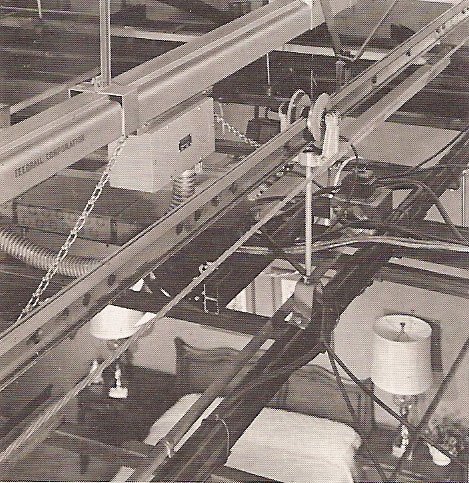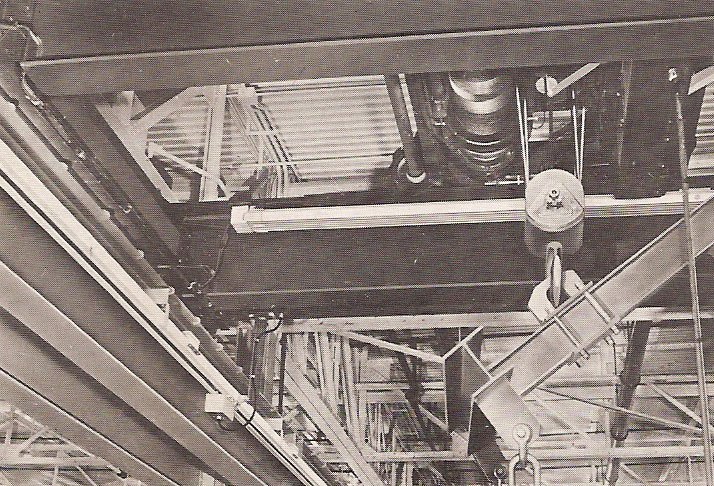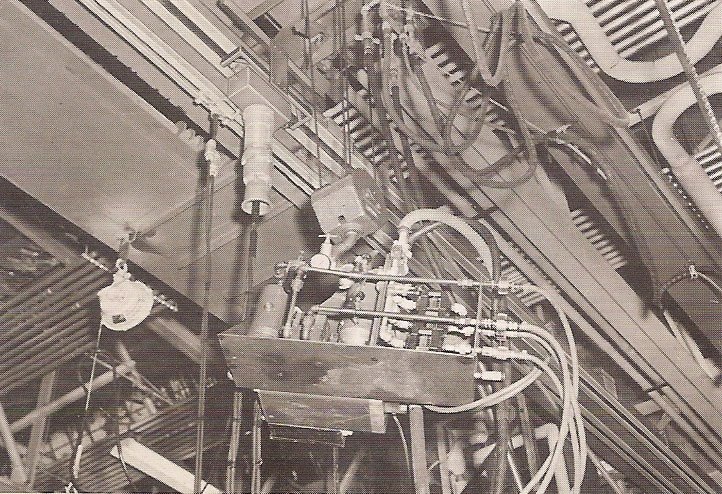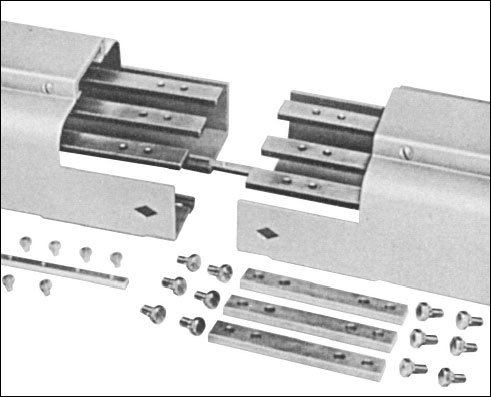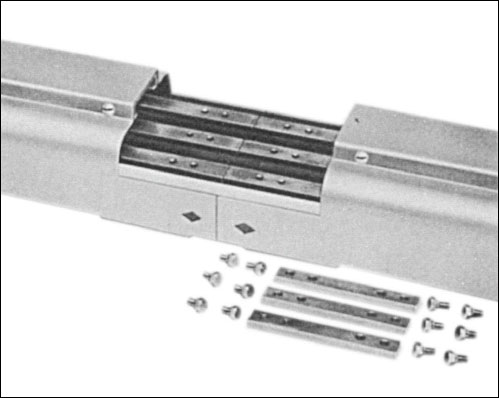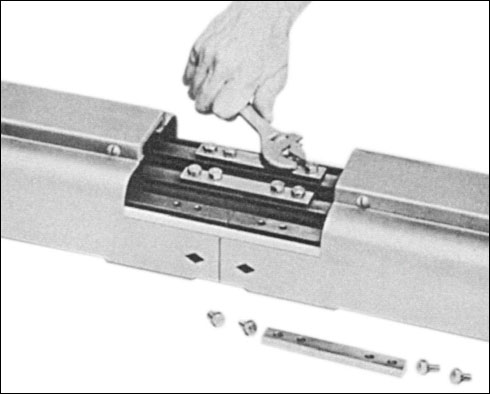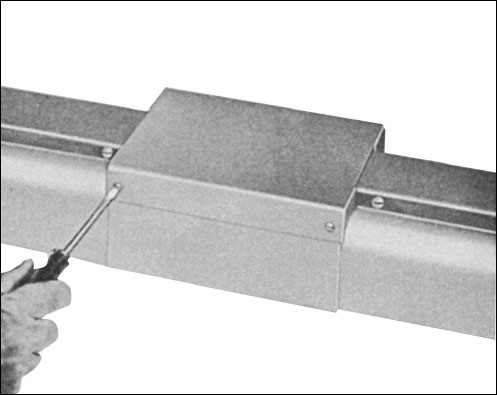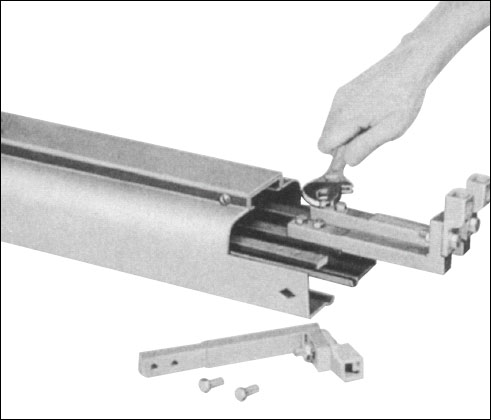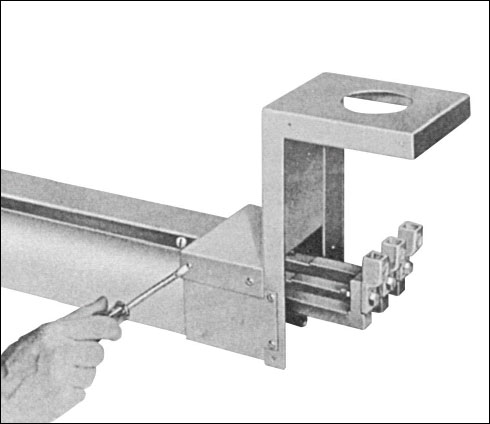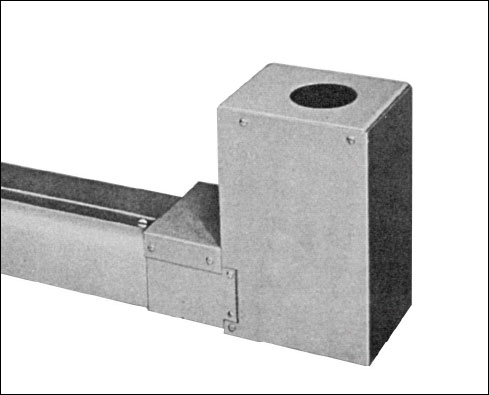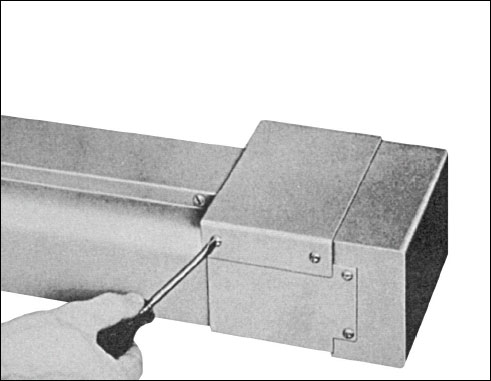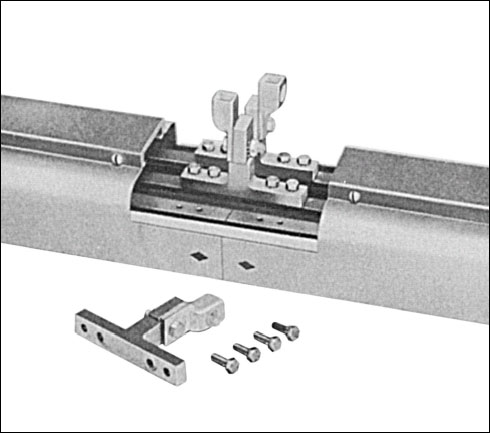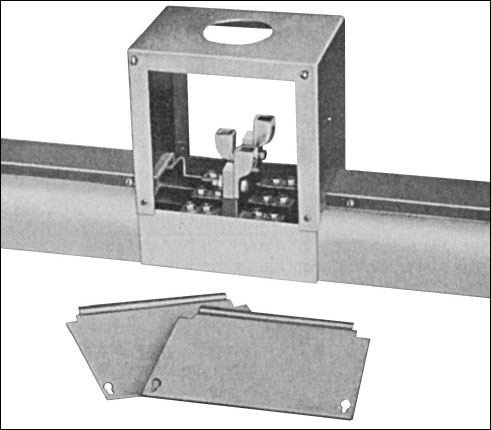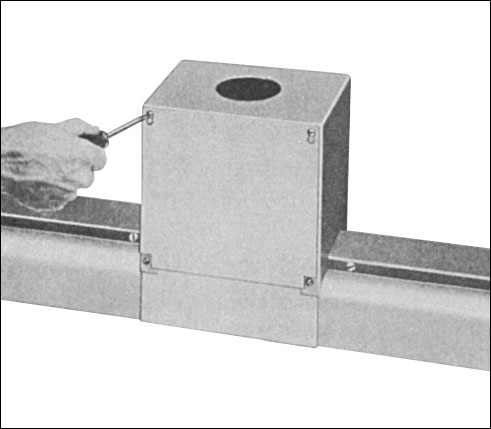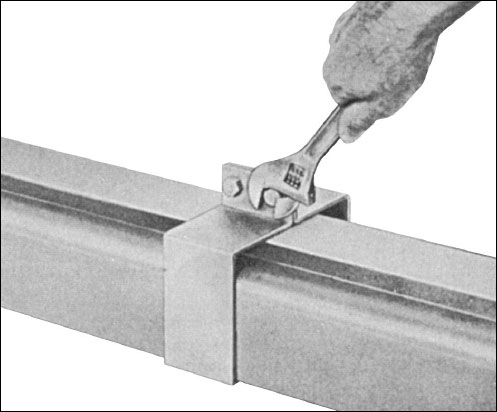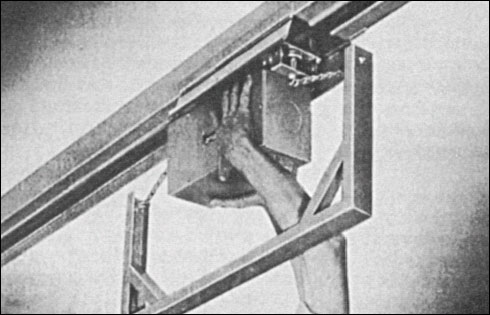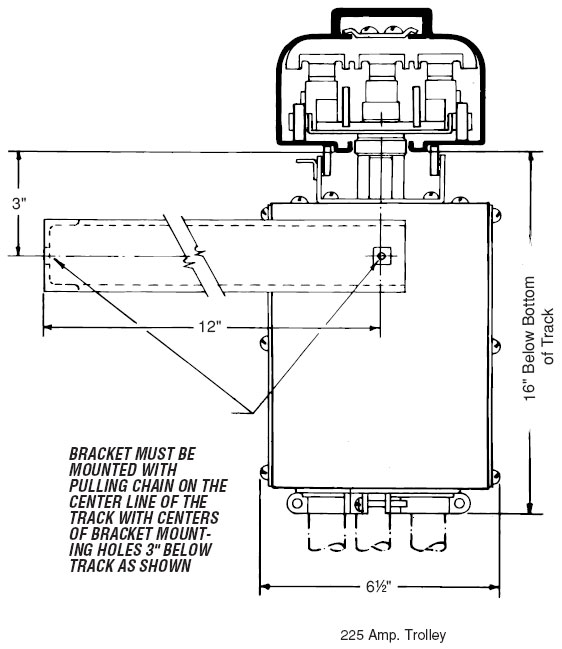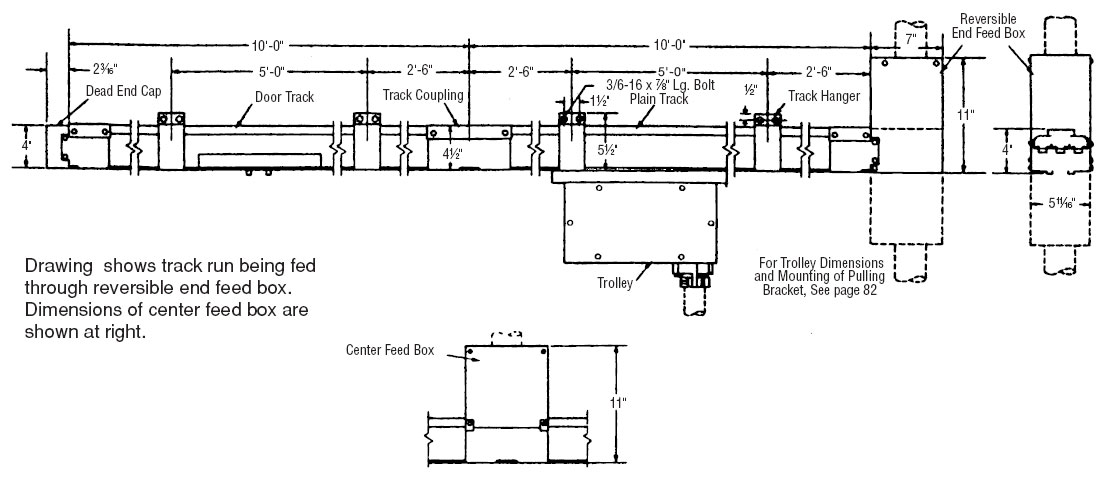Feedrail FH Heavy Duty Trolley Series
Heavy Duty Crane & Hoist Electrification Systems for Movable Trolley Service
General Information:Feedrail® systems are capable of providing multi-purpose trolleys or stationary plug-ins for installations requiring a source of electrical power which can be reconfigured without rewiring. These systems provide moveable outlets for electrical power along their entire length. The systems are especially suited for use where conventional wire systems would be cumbersome and costly. Plug-in Jacks with stationary power take-offs, are available for all Feedrail® systems. The busway-supported outlets called “trolleys” (Feedrail® 60 system only) make contact with the enclosed bus bars and provide a continuous moveable connection for electrical devices. The trolleys are easily inserted and removed through door-busway sections. As additional outlets are needed, trolleys (Feedrail® 60 System only) or stationary plug-ins can be quickly and efficiently inserted, their numbers being limited only by the current-carrying capacity of the busway and the capacity of each outlet. Reliable design assures uniform contact pressure, limiting work stoppages due to electrical and mechanical interruptions in supplying power. Advantages of these systems include low installation costs with complete re-usability; ease of adding outlets as required; electrical and personnel safety; compactness; dependability and minimum maintenance expense. All “busway (track) sections” are factory assembled for ease in handling and rapid installation. No special tools are required. Systems are designed for indoor use in non-hazardous, non-corrosive, dry atmosphere. |
Basic Information:
More Information:
|
UL & CSA Listed
Feedrail® is listed by Underwriter’s Laboratories, Inc. (U.L.) under BUSWAYS AND ASSOCIATED FITTINGS (File E11348 for Feedrail® / File E165922 for Electro-Rail®) and as a CRANE AND HOIST ELECTRIFICATION SYSTEM (File E31188 for Feedrail®). Feedrail® is also listed by the Canadian Standards Association (C.S.A.) under WIREWAYS AND BUSWAYS (File LL-7907 for Feedrail® / File LL 103287-1 for Electro-Rail®).


FH Heavy Duty Crane & Hoist System — What It Is and What It Does
Current Carrying Capacity
- No. FH2100 225 amperes (continuous); 300 amperes (intermittent). Trolleys rated 225 amperes (continuous).
- No. FH3100 375 amperes (continuous); 425 amperes (intermittent). Trolleys rated 375 amperes (continuous).
- No. FH5100 500 amperes (continuous); 575 amperes (intermittent). Trolleys rated 500 amperes (continuous).
Voltage
600 volts A.C. - 250 volts D.C.
Track Supports
Supports are of heavy gauge steel. Two supports are required for each track section to provide support every five feet.
Track
Track sections consist of a brake pressed one-piece 13-gauge zinc coated steel housing and the enclosed current carrying bus bars and insulators, all factory assembeld in convenient lengths ready for easy fool-proof instalation on the job. The lower horizontal portions of the housing serve as smooth, rigid runways for the trolleys.
Heavy Duty track sections are available in various types - Plain, Door, Sectionalizing, and Expansion track sections.
Bus Bars are of hard drawn copper. They are amply proprotioned to carry the specified current or 225 / 375 / 500 amperes per pole continuously, or 300 / 500 / 575 amperes per pole intermittently, without over-heating.
Bus bar connectors assure full current carrying capacity accross the joints without interferring with the free travel of the trolley contacts.
Insulators are made of a high insulating and arc-resistant material.
Trolleys
Basically, all Feedrail® heavy Duty trolleys have a chassis-insulator-contact assembly. The chassis is of heavy gauge steel. The trolley wheels and guide wheels are of the ball-bearing type. A substantially proprotioned insulator block combines the best insulation properties with high arc resistance.
Feedrail® Heavy Duty trolleys are furnished with silver alloy BRUSH CONTACTS for movement up to 500 feet per minute. For rate of travel or conditions other than above please consult technical service group.
A polarizing tab on the chassis, operating in conjunctin with a stop in the door track section, permits insertion of the trolleys only one way. Equipment grounding may be made through the trolleys. Weights in excess of 40 pounds per trolley are not recommended.
Grounding
For the safety of personnel, the track casings of the Feedrail® system may be used as an equipment grounding conductor for grounding equipment through the individual trolleys.
Equipment grounding may be made by using the grounding lug within the box. track housing must be grounded through conduit or other suitable means.
Feedrail® Heavy Duty systems are designed primarily for indoor services in essentially dry locations. Feedrail® systems are electrified tracks in which the current carrying components are enclosed in protective steel housings. Smooth riding internally track-supported trolleys take off current and provide electric power for crane and hoist or other types of electrification systems.
The Feedrail® Heavy Duty systems have been specifically developed to provide safe electrification for crane bridges, monorail-hoist installations, test lines, machine tools and similar applications.
The Feedrail® Heavy Duty Systems are made up of standardized units, factory assembled for fast, complete installation without on-site fabrications.

Typical Installations
ApplicationsHeavy Duty Feedrail® systems find new applications daily wherever convenient movable power sources of 225, 375 or 500 amperes are needed. There is virtually no limit to thier use. A few applications are illustrated here. |
|
Joining Straight Sections with Coupling Plate
Mounting Reversible End Feed Box
Mounting Dead End Cap
|
|
Coupling Sections with Center Feed Box
Installing Track Hangers
Installing Sectionalized Track
Building Expansion Track
At least one Expansion Track section should be installed in each 400 ft. of track run to compensate for the cumulative differences in expansion and contraction between the steel casings and copper bus bars. Additional Expansion Track sections may be required if the installation is subjected to a wide range of temperature changes.
Expansion Track sections must be used wherever an installation is made across a building or structural expansion joint.
The standard 10' Expansion Track section is designed to provide 2" of expansion and 2" of contraction above and below the normal 10' length, at 75°F. At the time of installation, the length of the Expansion Track section must be set in accordance with the table below.
When used at points other than a building or structural expansion joint to compensate for unequal expansion or contraction between the steel track housing and copper bus bars, support the Expansion Track section by the coupling plates at each end and by the center support plates from suitable support brackets.
When used across a building expansion joint, center the Expansion Track section across the building expansion joint and support at each end from coupling plates and from the center support plates. Center support must be on the same side of the building expansion joint as the side of the expansion section stenciled "STATIONARY."
Length Settings for Standard 10' Expansion Track |
|||
|
Installation Temperature |
Distance in Feet * |
||
|
100 |
200 |
400 |
|
|
100°F |
9'11-3/16" |
9'11-5/8" |
9'11-1/4" |
|
75°F |
10' |
10' |
10' |
|
50°F |
10'3/16" |
10'3/8" |
10'3/4" |
|
25°F |
10'3/8" |
10'3/4" |
10'1-1/2" |
|
* Distance Represents: |
|||
Mounting of Heavy Duty Trolleys
Installation Planning
Before a Feedrail® system can be planned or an estimate of the cost prepared, the electrical and mechanical requirements that the system must meet should be known. The following outlines list the basic data needed for all applications and the additional data required for various specific applications.
Basic For All
- Describe in detail the purpose of the Feedrail® Heavy Duty System. Will it be used with existing equipment?
- How many conductors will be required?
- What voltage and current is to be applied to each conductor? Where is the power source located?
- Details about any special requirements or conditions which the installation must meet such as moisture, corrosive fumes, high or low temperatures, etc.
For Electric Cranes
- Sketch giving number, location, length of crane runways and length of bridge. Show location of building expansion joints, if any.
- How many conductors will be required on each bridge run? - How many for power? - for control? How much current must each conductor carry?
- What is the maximum travel speed of the bridge? - of the hoist?
- List of the crane’s motors — main hoist, auxiliary hoist, bridge travel, trolley travel — giving the type (D.C., wound rotor, squirrel cage, etc.) of each motor and its horsepower and full-load ampere rating.
For Electric Hoists
- Plan view sketch of the rail system on which the hoists will travel, giving the length of run of straight sections, radii of any curves and dimensions of any switches. What is the minimum distance from Feedrail® to crane rail in order to clear hoist? Show location of building expansion joints or expansion joints in the structure from which the Feedrail® will be supported.
- How many hoists will be used and what is the horsepower and full load current rating of each? Include horsepower and full load current rating of travel motors of any of the hoists that are motor propelled. What are the maximum travel speeds?
For Production Machines
- Sketch with dimensions to show the location and space available for the Feedrail® system. Indicate range of roof deflection due to snow loads, temperature changes, etc.
- Plan view showing exact sizes and locations of tailgates. Give location of expansion joints, if any, in the upper door guides and in the hangar roof structure. Indicate size and number of doors and pattern of door movements.
- List the number of conductors required and give voltage and amperage requirement of each. Give horsepower and full load current rating of the motors.
For Special Requirements
- Plan view sketch with all dimensions which are necessary to make clear the location and extent of the Feedrail Heavy Duty. Show the location of the power source.
- Full details about equipment which will be operated from the system, including :
- Horsepower and full-load current rating of any electrical motors.
- Fusing arrangements required.
- Number of outlets needed.
Preventive Maintenance
At all times Feedrail® equipment should be so protected and maintained as to be kept clean and dry.
Before the Feedrail® system is placed in operation, it should be thoroughly checked for horizontal and vertical alignment, adequate track support, and free movement of trolley travel throughout the entire track run. All track, bus bar and feed connections should be mechanically tight. The system should be checked for possible grounds or short circuits. Any paint, grease, or other foreign matter accumulated during construction should be removed from the bus bars, insulation and track interior. Blow out all dust and other loose particles from inside the track.
Expansion sections, when used, must be properly adjusted, located and supported in accordance with installation instructions. Check bus bars and casing for accurate alignment.
Feedrail® is both an electrical and a moving mechanical system and therefore should be included as a part of your Preventive Maintenance Program.
Electrical Maintenance requires:
- Keeping the System dry and clean to prevent electrical leakage or “shorts” across the insulation.
- Maintaining electrical continuity by keeping bus bar contact surfaces clean and joints tight.
Mechanical Maintenance requires:
- Preventing excessive wear.
- Replacing parts showing excessive wear.
The following Preventive Maintenance procedure, periodically performed is recommended:
- Remove, thoroughly clean all trolleys and lubricate the wheels. Feedrail® recommends Grade #1 Bearing Grease. This is softer grease than #2 and allows the grease to penetrate the bearings easier. Inspect contacts for excessive wear. Replace worn wheels and contacts.
- Clean bus bars with Feedrail® Track Cleaning Tools.
- Blow out all foreign particles which have accumulated inside the track.
- Check trolleys for free movement within the track.
Check all track supports, track joints, bus bar and feed connections for tightness.
This procedure should be repeated at regular intervals, consistent with the severity of the operations and usage of the system. Plants operating two or three shifts will require more frequent inspection of the Feedrail® equipment. Feedrail® is not normally recommended for installations subject to vibration, frequent electrical overload, corrosive fumes and other abnormal conditions. However, should such conditions exist, more frequent inspection and maintenance will be required.
Before additional electrical loads are added to the system it should be determined that sufficient capacity is available.
FH Series (Feedrail® HD) – Basic Dimensions/Mounting Methods
Basic Dimensions of Feedrail Heavy Duty Systems
The following are the basic dimensions of the Heavy Duty Feedrail® System. These are offered as a guide only.
Mounting Methods
Examples of the methods commonly used for mounting Feedrail® Heavy Duty Systems track runs are shown below. These methods can be used in existing plants as well as in new buildings. In every case the mounting should be designed to insure a rigid installation in both horizontal and vertical alignment. Rod or strap supports should not exceed 2 feet in length without sway bracing.
Build Your Feedrail FH Heavy Duty Trolley Series
All of the components you'll need to build a brand new Feedrail FH Series system have been organized below by category. It is recommended that you start with Track Sections and work your way through each category in the order they're presented. If you have any questions, please contact us and one of our highly trained Feedrail specialists will respond shortly.
 Track Sections |
 Track Accessories & Hangers |
 Trolleys |
 Track & Busway Cleaning Tools |
 Replacement Parts |
Shop for FH Heavy Duty Trolley Series System Components, Parts & Accessories
All components, parts and accessories for the Feedrail FH Heavy Duty Trolley Series System can be found below. Use the product filter menu to narrow your search.
Track Sections
Sections complete with Bus Bars. 10 feet is standard length. Shorter lengths furnished on special order.
Track Sections, Door Track
Door track sections are identical to plain track except for the addition of two hinged doors in the bottom for the insertion and removal of trolleys. When closed, the doors are securely locked and accurately aligned witht he rest of the track to form an ininterrupted runway for the trolleys. Hinged doors are easy to open or close. No tools are required. Pressing pins together against spring pressure releases locking bolts. Door openings are polarized so trolleys cannot be inserted in improper polarity.
Track Sections, Expansion Track
Expansion Track sections are for use where it is necessary to compensate for the difference in total expansion or contraction between steel track housings and copper bus bars. They must be used on installations across building or structural expansion joint. To learn more about FH Heavy Duty Series expansion track, click here.
Expansion Track
 Expansion Track sections are for use where it is necessary to compensate for the difference in total expansion or contraction between steel track housings and copper bus bars. They must be used on installations across building or structural expansion joint.
Expansion Track sections are for use where it is necessary to compensate for the difference in total expansion or contraction between steel track housings and copper bus bars. They must be used on installations across building or structural expansion joint.
At least one Expansion Track section should be installed in each 400 ft. of track run. Additional Expansion Track sections may be required if the installation is subjected to a wide range of temperature changes.
The standard 10' Building Expnasion track section is designed to provide 2" of expansion and 2" of contraction of the steel housing above and below the normal 10' length at 72°F). If the temperature at the time of installation is other than 75°, due comensation must be made according to the chart below. The bus bars and track housing in this section telescope to provide a continuous surface for trolley contacts and the ball bearing support wheels of the trolley. Enclosed flexible jumpers connect the bus bars and maintain full current carrying capacity across the joints.
Length Settings for Standard 10' Expansion Track
| Installation Temperature | Distance in feet * | ||
|---|---|---|---|
| 100°F | 9' 11-13/16" | 9' 11-5/8" | 9' 11-1/4" |
| 75°F | 10' | 10' | 10' |
| 50°F | 10' 3/16" | 10' 3/8" | 10' 3/4" |
| 25°F | 10' 3/8" | 10' 3/4" | 10' 1-1/2" |
| For other temperatures, consult technical service group. * Distance represents: (1) Footage between expansion track sections on installation having more than one expansion track section. (2) Overall length of run on installation having only one expansion track section. |
|||
Continuous Rating: 175 Amperes or 225 Amperes - 600 volts A.C., 250 volts D.C.
Intermittent rating: (1 minute off, 1 minute on) 250 Amperes or 300 Amperes - 600 volts A.C., 250 volts D.C.
Sections complete with Bus Bars.
10 feet is standard length. Shorter lengths furnished on special order.
Track Accessories
Trolleys
The same efficient engineering and clean-cut construction which is a hallmark of the entire Feedrail system is evident in the internally track supported Heavy Duty trolleys. To learn more about FH Heavy Duty Series trolleys, click here
Trolleys
The same efficient engineering and clean-cut construction which is a hallmark of the entire Feedrail system is evident in the internally track supported Heavy Duty trolleys.
The chassis of these trolleys is of one piece heavy gauge steel. It is equipped with heavy duty enclosed ball-bearing wheels for support; horizontally mounted ball-bearing guide wheels running in the slot of the track to prevent slewing; and ball-bearing wheels on pivoted arms of the undercarriage to prevent upthrust. This wheel combination assures smooth, easy running trolleys.
The insulator-contact assembly consists of a substantially proportioned mechanically strong arc-resisting insulator block on which the contact brushes are mounted and held in true alignment. Spring keep the brushes in continuous firm contact with the bus bars. The insulator-contact assembly is fastened by machine screws and can be removed as a unit.
Specially designed heavy duty silver alloy brush type contacts assure full current carrying capacity. Brushes are individually spring loaded and maintain full contact pressure and alignment with the bus bars at all times.
A heavy gauge sheet steel terminal box with removabe side cover is supported by the trolley chassis. This box serves to enclose the solderless type pressure connectors which are used to make cable connections to the trolley.
Lugs take either aluminum or copper cables. Heavy duty cable grips prevent strain on the terminals.
Trolleys are designed for operation at speeds up to 500 feet per minute. A bracket and chain linkage is provied for connecting the trolleys to the powered equipment. Chains are factory adjusted for correct propelling of the trolley in the track run.
Cleaning Tools
These special trolley-mounted Dust Remover and Bus Bar Cleaners are quickly and easily used to keep a Feedrail "Multi-Conductor" System in prime working condition. Ther are inserted through the door track section, with the power off, and simply pulled back and forth along the length of a track run, cleaning all bus bars at the same time. Their frequency of use will depend upon the severity of foreign matter accumulations, although a regularly scheduled preventative maintenance program is highly recommended.
Replacement Parts
Feedrail FH Series Heavy Duty 10' Straight Track, 3 Pole, 225 Amp
Item Number: FH2100
Heavy duty 10' straight track for FH Series (Feedrail® HD). 3 poles, 225 amps.
Feedrail FH Series Heavy Duty 10' Straight Track, 3 Pole, 375 Amp
Item Number: FH3100
Heavy duty 10' straight track for FH Series (Feedrail® HD). 3 poles, 375 amps.
Feedrail FH Series Heavy Duty 10' Straight Track, 3 Pole, 500 Amp
Item Number: FH5100
Heavy duty 10' straight track for FH Series (Feedrail® HD). 3 poles, 500 amps.
